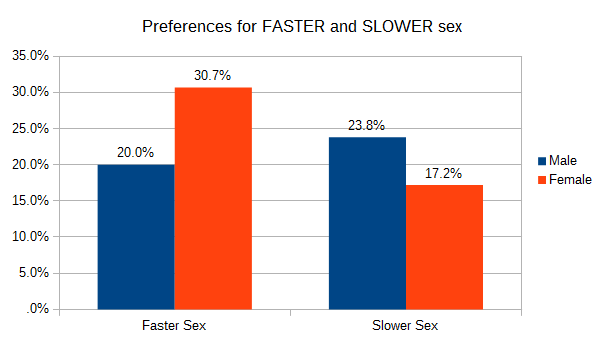Regular Article
The Pace of Sex: Individual preferences for the frequency of Faster vs. Slower sexual behavior
Petra Zebroff
Abstract
Objectives:
The pace of sex is one component of the sexual experience vital in building sexual arousal and for reaching orgasm. Controlling the speed of thrusting (in intercourse) has been found to increase orgasm potential in women, aid in erection and ejaculation control in men and decrease pain following cancer treatments and after hysterectomy. A slower pace is considered more body-centered and sexually fulfilling, especially for women.
The objective of the current study was to determine whether there are individual preferences for a faster or slower pace of sex and how this preference differs between individuals. It is assumed that women and older people prefer a slower pace of sex more often than men or younger people.
Method:
38 items measuring arousal preferences were given to 500 men and women in an online questionnaire linked from articles describing sexual arousal on popular content websites. Participants were asked to define their preferred pace for sex — what percentage of the time and combination they would desire sex to be either faster or slower.
Results:
While half of the participants (50.2%) preferred a pace of sex that included an equal division of fast-slow pace, a significant difference was found between participants who preferred sex at a faster pace from those who preferred a slower pace. The hypotheses that women prefer slower sex more often than men was not supported. Women were more likely to report a desire for a faster pace “more than half, or all of the time” (30.7%) than men (20%).
A preference for a faster pace was associated with people under the age of 35 (p=.019) and being female (p=.082).
A desire for a slower pace is primarily associated with age, being over 35 (p=.092). Gender was secondary, with men preferring a slower pace than women. Desire for a slower pace was strongly associated with relationship dissatisfaction (p=.003).
Discussion:
Differences in preferred sexual pace were significantly related to age, gender and relationship satisfaction. The conversation about the pace of sex is complex, with the media portraying a faster pace as beneficial for “passion” and therapists promoting a slower pace for increased sexual function and satisfaction.
These results indicate that the all-in-one approaches regarding the pace of sex are not adequate, especially with gender stereotypes. Implications for therapists are discussed. Further study is needed to understand the relationship between relationship satisfaction and a desire for a slower pace of sex.
————————————————————————————————————
References:
Barratt, B. B. (2013). Sensuality, Sexuality and the Eroticism of Slowness. Culture of the Slow: Social Deceleration in an Accelerated World, 136.
Daedone, N. (2011). Slow sex: The art and craft of the female orgasm. Grand Central Life & Style.
Eichel, E. W., De Simone Eichel, J., & Kule, S. (1988). The technique of coital alignment and its relation to female orgasmic response and simultaneous orgasm. Journal of sex & marital therapy, 14(2), 129-141.
Gallup, G. G., Burch, R. L., Zappieri, M. L., Parvez, R. A., Stockwell, M. L., & Davis, J. A. (2003). The human penis as a semen displacement device. Evolution and Human Behavior, 24(4), 277-289.
Katz, A. (2003). Sexuality after hysterectomy: a review of the literature and discussion of nurses’ role. Journal of advanced nursing, 42(3), 297-303.
Katz, A. (2005). The sounds of silence: sexuality information for cancer patients. Journal of Clinical Oncology, 23(1), 238-241.
Masters, W. and Johnson, V. (1970) Human Sexual Inadequacy.Boston: Little Brown
McCarthy, B. W. (1981). Strategies and techniques for the treatment of ejaculatory inhibition. Journal of Sex Education and Therapy, 7(2), 20-23.
McGill, T. E. (1962). Sexual behavior in three inbred strains of mice. Behaviour, 19(4), 341-350.
Savage, E. S. & Bakeman, R. (1978). Sexual morphology and behavior in Pan paniscus. In R. Chivers and J. Herbert (Eds.) Recent advances in primatology. pp. 613–616. New York: Academic Press
Thompson, L. (2011). In Praise of Speed: The Value of Velocity in Contemporary Cinema. Dandelion, 2(1).

 Follow
Follow
Leave A Comment